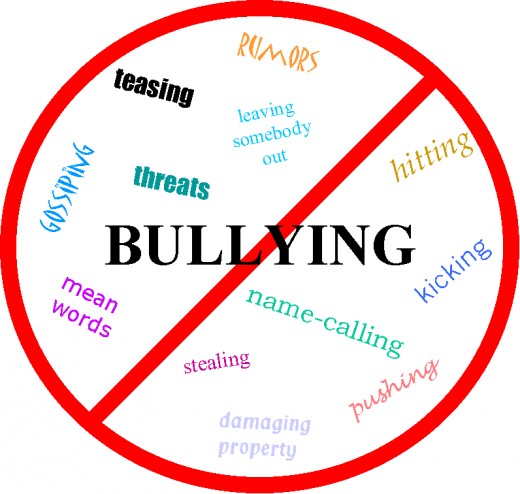Bullying - How to Recognize the Symptoms of a Victim

Buy more information on bullying:
The Bully and the Victim(s)
Bullying. It is something that students, parents, co-workers can face in school, home or at work.
What is it? Bullying is repetitive and intentional actions that are hurtful to another person. These actions can be carried out by one person or by a group of people. Bullying is not part of a normal group setting nor is it a part of normal growing up behaviour. It cannot be tolerated. Bullying is not friendly teasing. It is intimidation, repeated over and over, and the action is intended to cause physical or emotional harm.
Bullying is a universal problem in the sense that it can occur in any place, at any time. It can happen to children and to adults. It can happen at school or at the work place. Bullying does not have a singular face or a singular action. The importance is to recognize it and learn how to deal with it.
What kind of person bullies? Anyone can become a bully. The behaviour of bullying is a learned one. Quite often, the bully has been a victim of bullying. The bully may have been a victim of bullying carried out by parents, siblings or peers. A bully chooses someone who is weaker than they are. Their chosen target might be a younger person, physically weaker or emotionally weaker. They choose a weaker person as they assert themselves to dominate and to retain control over the victim. It is actions based on contempt, not anger. The bully does not feel compassion or empathy towards the victim. They have no respect for the victim. They believe the victim is worthless and inferior.
How does bullying look like? Bullying can appear in many forms. Some examples include name calling, stealing of lunches/snacks, stealing of property, pushing, hitting, stepping on, requiring payment for protection, ostracizing and so on.
Who notices? Bullying can be carried out without being noticed by teachers, principals or management. The bully causes the victim to become more afraid of him through threats should the victim intend to report the bully’s actions to authority. The victim, who already is afraid of the bully, becomes even more intimidated and fearful of the perpetrator, continues to keep silent. The bullying continues and the cycle continues between bully and victim. It is not unusual for the bully to have more than one victim, yet each victim is kept unaware of each other. In other words, divide and conquer.
How do you stop bullying? The way to stop bullying is for the victim to take action. Action can happen solitarily or with the help of others. In the case of children, it is necessary for the parent or another adult to recognize the symptoms of being a victim to bullying. If you believe that a child is being bullied, ask him or her whether this is happening. It is important that the child trusts you and believes that you are genuinely there to help. If he/she does, then he/she will open up.
Be proactive. Observe. Notice the details. Is he/she coming home with torn clothing? Are there more physical injuries than normal? Are the given reasons for the injuries realistic? Are the injuries normal? Are there mood changes? Are there increased mood swings? Is there avoidance of school (being sick more often without any explanation or proof)? Is personal property being damaged more often? Is personal property damage normal? Is personal property missing and is it occurring more often? Is there increase in appetite at the end of the day? Is there an increase in requests for money or request for increases in allowance? These are all possible indicators of being a victim of bullying. Keep a log of what you find and the date. If there is bullying, this log will help you put things in perspective with the right authorities.
Be open and keep communication open. Listen. Ask questions. Always remind your children that you are there for them and that there is nothing that they cannot speak to you about. Ensure that they understand that they can come and speak to you about anything, even if they think that they have done something wrong or even when someone has threatened them. Children need to know that you are there to help them and to protect them, regardless of who is at fault and of the outcome.
In some instances, the child may be in extreme fear of the bully. In these cases, the child will not open up and admit that he/she is being bullied. If you suspect this is the case, the best option is to approach his/her teacher. Speak openly and follow up with the teacher and the child.
If your suspicions are confirmed that your child is a victim of bullying, take immediate action. Speak to the child’s teacher and principal. Demand their action plan and a resolution to stop the situation. In some schools, the bully is given an in-school detention. The theory is that you cannot teach a bully to stop by bullying him; therefore, implementing “formative consequences that teach” is the answer. In other words, make the consequences something that the bully can learn from. If physical violence has occurred, consider contacting the local police.
Bullying. It cannot be tolerated.
Beth100
Copyright 2009
A Canadian teacher, Bill Belsey, realized the importance of learning about bullying. He has created several websites that are used by students, teachers and pr
- www.bullying.org
Bullying.org's purpose is to eliminate bullying in our society by supporting individuals and organizations to take positive actions against bullying through the sharing of resources, and to guide and champion them in creating non-violent solutions to - www.cyberbullying.ca
"Cyberbullying involves the use of information and communication technologies to support deliberate, repeated, and hostile behaviour by an individual or group, that is intended to harm others." -Bill Belsey - Bullyingcourse.com
Bullying is a universal issue that touches almost every person, family, school, business or community at one time or another regardless of age, gender, race, religion or socio-economic status. Bullying is not only a "school" issue, bullying is a broa
Read this to learn the signs of abuse:
- What is Child Abuse and How to Spot it
Child abuse is any harm done to a child by someone responsible for the care of that child. Abuse may be a singular incident or a pattern of behavior. It can take place anywhere, from a child's home,...









